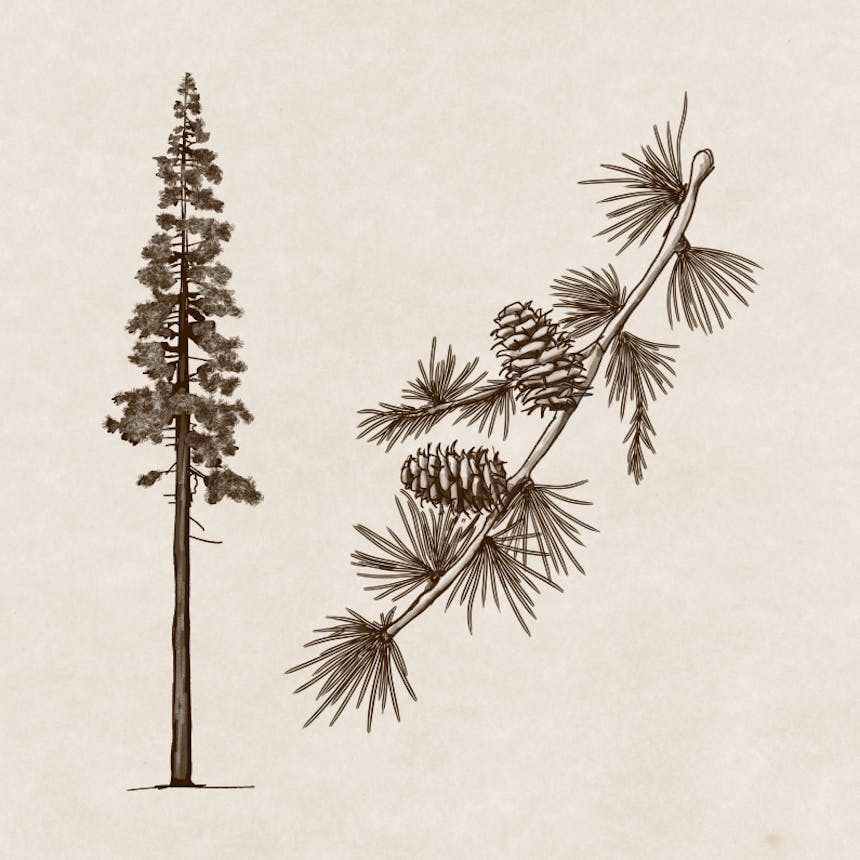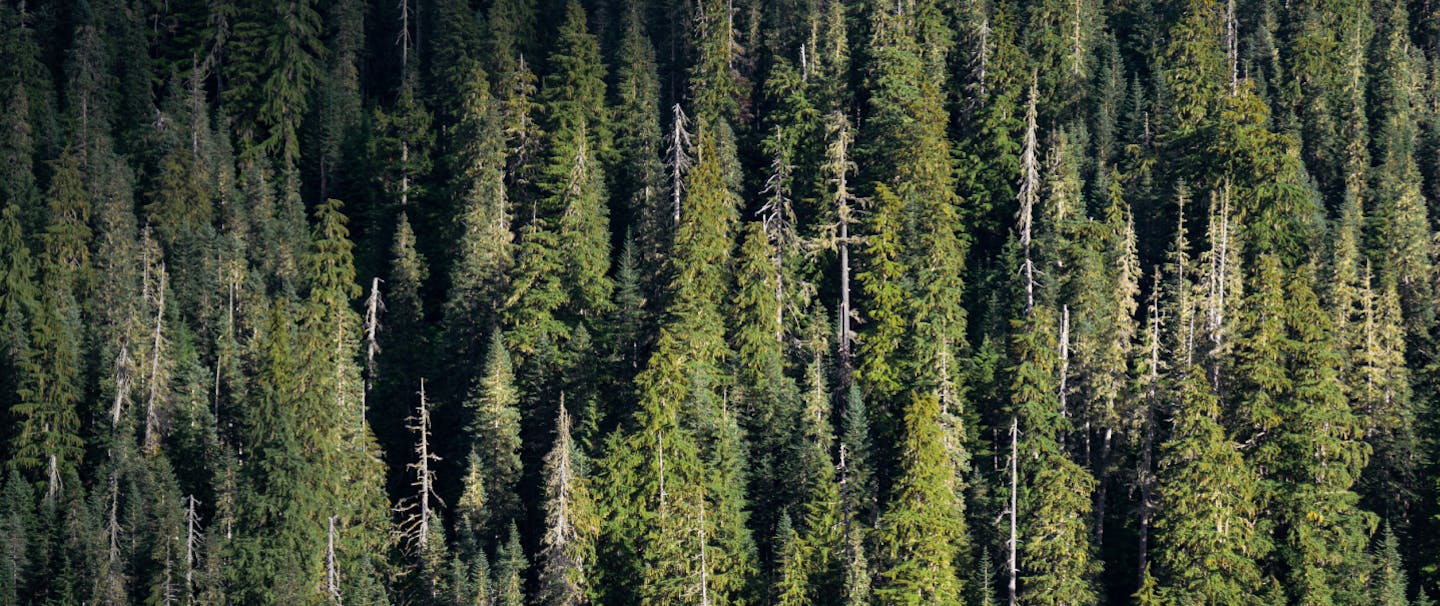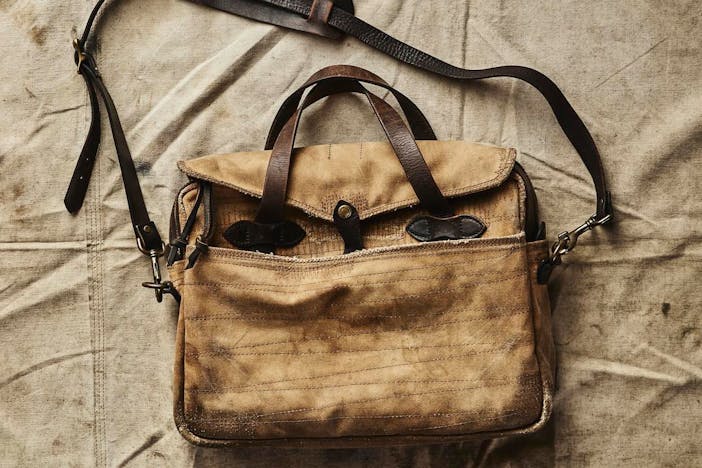Douglas Fir (Pseudotsuga menziesii)
Identification: Needles soft and blunt-tipped, with two white bands underneath. They cover twigs like bottle brushes.
Buds: Sharp-pointed with red-brown overlapping scales.
Cones: 3-4” long with three-pointed bracts sticking out between the scales that look like the back legs and tails of mice.
Bark: Young bark has resin blisters. Mature bark is deeply furrowed and reddish-brown.
Size: 250’ tall and 10’ in diameter.
Very important economically and an abundant conifer in the Pacific NW and the mountains of the interior West. Douglas fir forests host diverse wildlife and can be good places to forage for golden chanterelle mushrooms.
Largest: 330’ tall and 11’ in diameter.
Oldest: 1,350 years.

Douglas Fir (Pseudotsuga menziesii)
Sitka Spruce (Picea sitchensis)
Identification: Needles 1” long, sharp and flat. Needles on top of twig point outward forming Vs and those below point straight out.
Cones: 1-3″ long with thin, wavy, irregularly toothed scales.
Bark: Thin, gray-brown, and scaly.
Size: 180’ tall and 5’ in diameter.
Majestic trees with straight trunks, buttressed bases with gray-brown scaly bark and conical crowns of horizontal branches. They grow on the coast, forming dry platforms with their roots in coastal swamps and growing upcountry onto the western slopes of the Cascades. Wood used in pianos, guitars, violins, and organs for its excellent resonance.
Largest: 248’ tall and 15’ thick trunk.
Oldest: around 1,300 years.

Sitka Spruce (Picea sitchensis)
Lodgepole Pine/Shore Pine (Pinus contorta)
Identification: Needles in packets of two, 1-3” long, yellow-green to dark green and commonly twisted.
Cones: Small 1-2”, egg-shaped, often with a prickle.
Bark: Thin, dark, and flaky.
Size: 100’ tall and 2’ in diameter.
Trees grow thickly with long, skinny, straight trunks in the mountains and crooked, windswept, shrubby shapes in the wind, sandblast, and salt spray of the coast. “Lodgepoles” from slim trees used to support teepees of indigenous peoples. These trees form dense stands and their serotinous (resinous) cones can use fire and high UV heat to open and release seeds or after long periods weathering on the tree.
Largest: subspecies murrayana, 118’ tall and 6’ in diameter.
Oldest: 471 years

Lodgepole Pine/Shore Pine (Pinus contorta)
Western Larch (Larix occidentalis)
Identification: Needles tassel-like, 14 or more needles per bundle, turn yellow, drop in the fall, growing out of large pegs on the twigs.
Cones: 1-2” long woody, “whiskery” cones with papery, needle-like bracts that extend past scales of cone.
Size: 180’ tall and 4’ in diameter.
Bark: Reddish-orange, furrowed when mature, flaking in irregular, large pieces.
The only deciduous (leaf-dropping) conifer native to the Pacific NW. The needles turn bright yellow in the fall and drop. These large, fast-growing trees are home to many cavity nesters, such as woodpeckers, flying squirrels, and owls.
Largest: 191’ tall and 4’6” in diameter.
Oldest: 920 years.

Western Larch (Larix occidentalis)
Western Hemlock (Tsuga heterophylla)
Identification: Needles short (3/4”), thin, flat, and blunt. They are green above and white underneath.
Cones: Small 1” egg-shaped, smooth-scaled cones. Numerous.
Bark: Thin, flattened ridges, inner bark rusty with purple streaking.
Size: 200’ tall and 4’ in diameter.
Treetops droop above narrow conical trees with pendulous branches and can thrive in heavy shade and cool, rainy conditions. A dominant species over much of its range, sharing space with Sitka spruce near the coast and Douglas fir in higher mid-slope elevations. Seedlings are able to establish on deadwood and colonize open forest stands after windfall. Important source of paper.
Largest: 273’ tall, growing among redwoods.
Oldest: 1,238 years.

Western Hemlock (Tsuga heterophylla)






